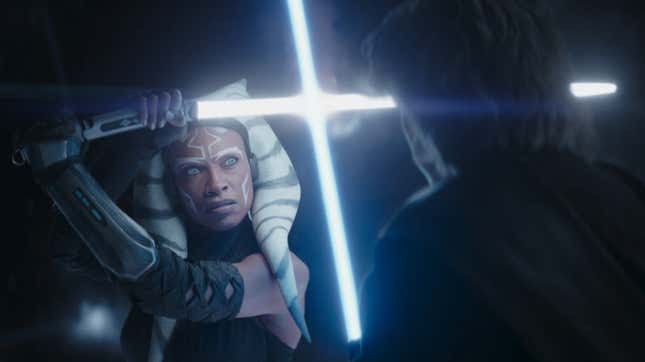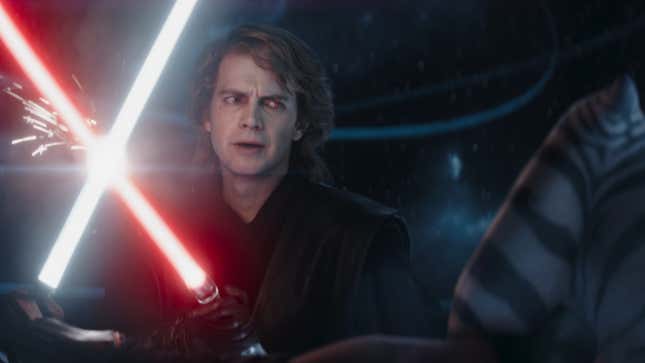موقع شبرون للتقنية والأخبار- متابعات تقنية: [ad_1]
This week’s episode of Ahsoka gave its titular hero one last opportunity to learn from a Master with a lot to learn himself, as Ahsoka’s time-bending trip through her life took her side by side, and up against, Anakin Skywalker. But in doing so, both Master and Apprentice alike looked to a future for themselves beyond the crucible the Jedi Order made them in.

“Shadow Warrior” takes Ahsoka on a journey through the battles that defined her childhood—a point distressingly made as her spirit is put into the body of her younger self, played by 16-year-old Ariana Greenblatt, making clear in ways Clone Wars never could just how young Ahsoka was. Guided by a vision of her former master, Anakin Skywalker, the final lesson he is to teach her is one of growth, and shedding the legacies of the past that they are both tied to. But it’s also one rooted in the prison Ahsoka and Anakin’s spirit yearn to be free of: an endless fight, from their youth all the way through to even whatever lies beyond in the cosmic Force.

At first, it’s hammered home literally as Anakin’s vision self ignites his lightsaber and swings repeatedly at his former student—fight or die, the lesson that always was and will be the crux of their relationship as Master and Apprentice. They had no other choice, after all: the Clone Wars thrust this life upon the Jedi Order, and the Jedi Order embraced it with open arms and blindness that had been damning their decline for generations. There was no choice for Ahsoka, a child, to be anything other than Commander Tano. She, and thousands of children like her—thousands of children like Anakin, too—were turned into weapons the never wanted to be. And so she was, a warrior on the front lines of war, charging into battle alongside her master, the most legendary warrior of them all. A legacy Anakin similarly had no choice in, and feared making his apprentice’s in turn. The Jedi Order made peacekeepers soldiers, and as Clone Wars intoned: good soldiers follow orders.
It’s telling that the three battlefields we are taken to in “Shadow Warrior” are all moments in the Clone War where the true reality of that legacy hits Ahsoka hardest. Teth, her first full combat experience alongside Anakin, Ryloth, a campaign where she was forced to confront her status as a Jedi and a leader of soldiers whose lives were in her hands as much as her own was, Mandalore, a grim reminder that even as Ahsoka could escape the system of the Jedi Order, the conflict that Order shaped her in still had her in its grasp. Is it any wonder that she found herself returned as Fulcrum in the age of the Rebellion, forever destined to wander the galaxy engaging in one fight after another like some wandering Ronin?

What Ahsoka’s vision, and the reflection of Anakin in it—and one of an Anakin still wrestling with his own relationship to a legacy of violence—gives her is a chance to move on from the crucible that had defined her so long. It’s telling that the only moment she stumbles in this spiritual journey is when she reflects the lesson back on Anakin’s spirit, when she doubts that she can be more than an endless warrior—and in doing so turns his reflection dark and twisted, to give herself another thing to fight. It’s not a lesson about Anakin at all, even if he himself faced similar struggles, forged in that same crucible, but about Ahsoka, so horrified by a life of conflict, not being able to see beyond it for so long. “You lack conviction,” Anakin growls, but it’s not the conviction to stand and fight, but the conviction to be more than that—more than her doubts of what she and her legacy can be. Until she makes the choice, disarming Anakin and tossing his saber aside, that there is a life to lead beyond that of a warrior.
And it’s like a switch flips. From almost the moment Ahsoka returns from her visions, there is a lightness and warmth to her that could never really surface in Ahsoka’s first four episodes, or her prior appearances in The Mandalorian and The Book of Boba Fett. While there, and here, she could push back against this legacy and cycle of conflict she thought had doomed her since childhood—be the Ronin, reject Anakin’s direct legacy in Luke’s Jedi academy, and the baggage that comes with it, attempt to, and fail, to teach her own rebellious student—she could never really escape it until this moment of catharsis, one forged not in battle but in letting go. Anakin’s final lesson is a gift that Ahsoka can shape herself anew, and be beyond the war that pushed them down their darkest, loneliest paths. No longer a tool forged in battle, but a person who can simply be, can choose to fight if needs be, but can also choose to just live.

Who exactly Ahsoka Tano is has long been the central struggle of her character arc—from the legacy of her master, to her exit from the Jedi Order, to who she was and what she meant to the galaxy in the age of the Empire. Now, at long last, she is free to shape that definition herself, instead of having it shaped for her.
Want more io9 news? Check out when to expect the latest Marvel, Star Wars, and Star Trek releases, what’s next for the DC Universe on film and TV, and everything you need to know about the future of Doctor Who.
[ad_2]



